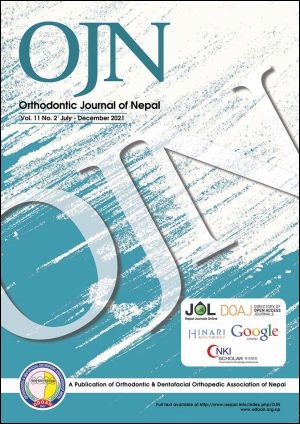Late upper airway constriction and its prevention by interceptive functional appliance therapy- A review
DOI:
https://doi.org/10.3126/ojn.v11i2.43284Keywords:
Airway constriction, Functional appliance, Pharyngeal airway, OSA, Upper airwayAbstract
Introduction: Sleep-disordered breathing (SDB) is one of the poorly diagnosed disorders which affects the quality of life of patients. The SDB is a spectrum of problems ranging from simple snoring to obstructive sleep apnoea (OSA) which involves complete collapse of the pharyngeal airway passage during sleep resulting in airflow cessation and consequent arousals. A noteworthy etiological factor of OSA is mandibular retrognathism. Imaging studies on craniofacial structures in OSA patients have shown decreased oropharyngeal and hypopharyngeal depth, elongated soft palate, altered tongue posture, and increased hyoid bone-to-mandible distance. The management modalities of OSA are positive airway pressure (PAP) and oral appliance therapy. The modus operandi of mandibular advancement devices (MADs) is the same as of myofunctional therapy instituted by orthodontists for the treatment of skeletal Class II malocclusions with mandibular retrusion in growing patients. By virtue of the increase in the mandibular length and advancement in mandibular position, pharyngeal airway space is enlarged along with favorable changes in the soft palate, tongue posture, and hyoid bone position. The focus of the present review is to consolidate the available literature on the long-term effects of functional appliance treatment. It is hypothesized that interceptive functional appliance therapy in the growing stage could be a viable strategy for the prevention of OSA development during adulthood. The review also highlights the importance of the need for more studies emphasizing the long-term impact of functional treatment to establish the role of the same in reducing the OSA treatment burden during adulthood.
Downloads
Downloads
Published
How to Cite
Issue
Section
License
Copyright (c) 2021 Orthodontic & Dentofacial Orthopedic Association of Nepal

This work is licensed under a Creative Commons Attribution 4.0 International License.
Copyright © held by Orthodontic & Dentofacial Orthopedic Association of Nepal
- Copyright on any research article is transferred in full to the Orthodontic & Dentofacial Orthopedic Association of Nepal upon publication in the journal. The copyright transfer includes the right to reproduce and distribute the article in any form of reproduction (printing, electronic media or any other form).
- Articles in the Orthodontic Journal of Nepal are Open Access articles published under the Creative Commons CC BY License (https://creativecommons.org/licenses/by/4.0/)
- This license permits use, distribution and reproduction in any medium, provided the original work is properly cited.




